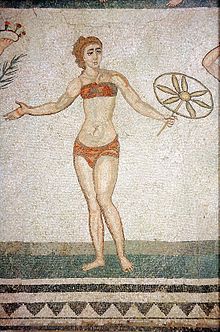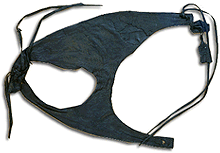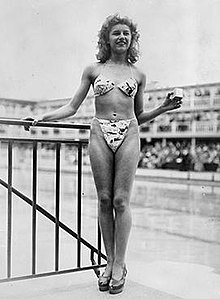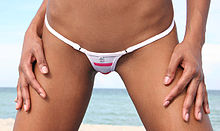| Revision as of 00:30, 22 February 2008 edit156.34.232.216 (talk) →String bikini: Replaced image.← Previous edit | Revision as of 00:34, 22 February 2008 edit undo156.34.232.216 (talk) →Variants: Replaced image, discuss on talk page if necessary.Next edit → | ||
| Line 27: | Line 27: | ||
| ==Variants== | ==Variants== | ||
| ] | ] | ||
| Throughout its history, the bikini has spawned many stylistic variations. Topless variations may still be considered bikinis, although technically no longer two-piece swimsuits. A regular bikini (i.e. not a variant) is defined as a two pieces of garments that cover the groin and buttocks at the lower end and the breasts in the upper end. Skimpier styles have narrow sides, including V-cut (in front), French cut (with high-cut sides) and low-cut string (with string sides). Other styles include a ] top - a rectangular strip of fabric covering the breasts, a top with cups similar to a ], and more modest bottom pieces such as briefs, shorts, or briefs with a small skirt attached.<ref>, WiseGeek</ref> | Throughout its history, the bikini has spawned many stylistic variations. Topless variations may still be considered bikinis, although technically no longer two-piece swimsuits. A regular bikini (i.e. not a variant) is defined as a two pieces of garments that cover the groin and buttocks at the lower end and the breasts in the upper end. Skimpier styles have narrow sides, including V-cut (in front), French cut (with high-cut sides) and low-cut string (with string sides). Other styles include a ] top - a rectangular strip of fabric covering the breasts, a top with cups similar to a ], and more modest bottom pieces such as briefs, shorts, or briefs with a small skirt attached.<ref>, WiseGeek</ref> | ||
Revision as of 00:34, 22 February 2008
| This article needs additional citations for verification. Please help improve this article by adding citations to reliable sources. Unsourced material may be challenged and removed. Find sources: "Bikini" – news · newspapers · books · scholar · JSTOR (October 2006) (Learn how and when to remove this message) |

A bikini or two-piece is a type of women's swimsuit, characterized by two separate parts — one covering the breasts, the other the groin (and optionally the buttocks), leaving an uncovered area between the two garments. It is often worn in hot weather and while swimming. The shapes of both parts of a bikini closely resemble women's underwear, and the lower part of a bikini can therefore range from the more revealing thong or g-string to briefs and the more modest square-cut shorts.
Sometimes the term bikini is used to describe the type of man's swimsuit also known as a speedo although real men's bikini swimsuits do exist that are not brief like.
History


Two-piece garments worn by women for athletic purposes have been observed on Greek urns and paintings, dated as early as 1400 BC. Ancient artwork from over 1700 years ago in Villa Romana del Casale have depicted women in garments resembling modern-day bikinis. Other bikini-style swimwear existed for many years before the first official bikini. Films of holidaymakers in Germany in the 1930s show women wearing two-piece bathing suits. They were to be seen again a year later in Gold Diggers of 1933. Two-piece swimsuits started appearing in the US when the U.S. Government ordered a 10 percent reduction in the fabric used in woman's swimwear in 1943 as part of wartime rationing. The July 9, 1945 issue of Life shows women in Paris wearing similar items.
According to the official version, the modern bikini was invented by French engineer Louis Réard and fashion designer Jacques Heim in Paris in 1946 and introduced on July 5 at a fashion show at Piscine Molitor in Paris. It was a string bikini with a g-string back. It was named after Bikini Atoll, the site of a nuclear weapon test called Operation Crossroads on July 1 in the Marshall Islands, on the reasoning that the burst of excitement it would cause would be like the nuclear device. Monokini, a bikini variant, derives its name, as a back formation, from bikini, interpreting the first syllable as the Latin prefix bi- "two" and substituting for it mono- "one", on the (perhaps intentionally) mistaken notion that the bi- element was the Greek prefix meaning "two".
Reard's suit was a refinement of the work of Jacques Heim who, two months earlier, had introduced the "Atome" (named for its size) and advertised it as the world's "smallest bathing suit". Reard 'split the "atome"' even smaller, but could not find a model who would dare to wear his design. He ended up hiring Micheline Bernardini, a nude dancer from the Casino de Paris as his model.
Catholic countries like Spain, Portugal and Italy banned the bikini. Decency leagues pressured Hollywood to keep bikinis from being featured in Hollywood movies. One writer describe it as a "two piece bathing suit which reveals everything about a girl except for her mother's maiden name." Movie star Esther Williams once said: "A bikini is a thoughtless act." Brigitte Bardot helped popularize the bikini in Europe in the 1950s, but the United States took longer to adopt it. Modern Girl magazine wrote in 1957, "It is hardly necessary to waste words over the so-called bikini since it is inconceivable that any girl with tact and decency would ever wear such a thing."
Ultimately the bikini caught on, due to a host of films and songs featuring the garment in the early 1960s.
In Malta, bikinis took time to be introduced. In the 1960s, the police fended off Bishop Michael Gonzi's request to ban bikini clad tourists following fear of compromising Malta as a tourist destination. Malta Labour Party girls felt safe putting on bikinis during beach parties but this was unacceptable by those supporting the Nationalist Party. The lower part of the bikini was further reduced in size in the 1970s to the Brazilian thong, where the back of the suit is so thin that it disappears into the buttocks. On beaches and certain parks in Europe, the top part of the bikini is sometimes not worn.
In 1996, when the Miss World contest was held in Bangalore, a dozen Indian groups opposed the event claiming that the contest degraded women by featuring them in bikinis. Social activist Subhashini Ali commented, "It's not an IQ test. Neither is it a charity show. It's a beauty contest in which these things have been added on as sops." The protests were so intense that the organizers were finally compelled to shift the venue of the "Swimsuit Round" to Seychelles. Afghan Miss Earth 2003 contestant Vida Samadzai was severely condemned by the Afghan Supreme Court, which said, "such a display of the female body goes against Islamic law and Afghan culture."
Variants

Throughout its history, the bikini has spawned many stylistic variations. Topless variations may still be considered bikinis, although technically no longer two-piece swimsuits. A regular bikini (i.e. not a variant) is defined as a two pieces of garments that cover the groin and buttocks at the lower end and the breasts in the upper end. Skimpier styles have narrow sides, including V-cut (in front), French cut (with high-cut sides) and low-cut string (with string sides). Other styles include a bandeau top - a rectangular strip of fabric covering the breasts, a top with cups similar to a push-up bra, and more modest bottom pieces such as briefs, shorts, or briefs with a small skirt attached.
String bikini
A string bikini refers to a bikini swimsuit that is scantier and more revealing than traditional bikinis. It gets its name from the string characteristics of its design. Rather than featuring a full single piece bottom, the string bikini consists of two triangular shaped pieces connected at the groin but not at the sides, where a thin "string" wraps around the waist connecting the two parts. String bikini tops are similar and are tied in place by the attached "string" pieces. String pieces can either be continuous or tied.
It is claimed that Brazilian fashion model Rose de Primo created the first string bikini when she had to sew one with insufficient fabric available to her for a photoshoot. The first formal presentation of string bikini was done by Glen Tororich, a public relations agent, and his wife Brandi Perret-DuJon, a fashion model, for the opening of Le Petite Centre, a shopping area in the French Quarter of the New Orleans, Louisiana in 1974. Inspired by a picture of a Rio De Janeiro fashion model in an issue of Women's Wear Daily, they had local fashion designer Lapin create a string bikini for the event. Models recruited by talent agent Peter Dasigner presented it by removing fur coats by Alberto Lemon on stage. The presentation was covered by local television stations and the New Orleans Times-Picayune newspaper, and was sent out via the wire news services of the Associated Press and United Press International.
String bikinis are one of the most popular variations of traditional bikinis. Male bodybuilders use string bikinis to better show their muscles in competitions. A string bikini is also a type of undergarment worn by both men and women. It is similar to but more revealing than a bikini. Women's string bikini underwear normally resembles the bottom of the string bikini bathing suit. Men's string bikini underwear consists of a front and rear section joined at the crotch but not at the sides. The tops of each piece join with either an elastic waistband similar to that found on briefs or to a thin piece of material or "string," leaving the sides exposed except for the string or waistband.
Monokini

Monokini, sometimes referred to as a unikini, is a woman's one piece beach garment equivalent to the lower half of a bikini. The term is used for different styles of one-piece swimsuits inspired by the bikini.
In 1964, Rudi Gernreich, an Austrian fashion designer, designed the original monokini in the US. Gernreich also invented its name, and the word monokini is first recorded in English that year. Gernreich's monokini looked like a one-piece swimsuit but cut off a bit below the breasts leaving them bare. It had only two small straps over the shoulders. It was not very successful. Many women who wanted to sunbathe topless simply wore the bottom part of a bikini. Manufacturers and retailers quickly adapted to selling tops and bottoms separately. Gernreich later created the lesser known pubikini.
In the 1960s, the monokini led the way into the sexual revolution by emphasizing a woman's personal freedom of dress, even when her attire was provocative and exposed more skin than had been the norm during the more conservative 1950s. Today, many monokinis are designed as the ultimate in sexy swimwear, using chains, strings, and strategic strips of fabric to join the upper and lower portions of the suit while still covering the basics of the female form. Today's styles are decidedly less racy than Gernreich's original design, but nonetheless are a revealing style of swimsuit.
The term monokini is also now used to indicate any topless swimsuit, particularly a bikini bottom worn without a bikini top. In recent years, the term has come into use for topless bathing by women: where the bikini has two parts, the monokini is the lower part. Where monokinis are in use, the word bikini may jokingly refer to a two-piece outfit consisting of a monokini and a sun hat. The term was coined by Rudi Gernreich.
Microkini

A microkini is an extremely skimpy form of a bikini. The designs for both women and men typically use only enough fabric to cover the genitalia. Any additional straps are merely to keep the garment attached to the wearer's body. Some variations of the microkini use adhesive or wire to hold the fabric in place over the genitals. These designs do not require any additional side straps to keep the garment in place. The most radical variations of the microkini are simply thin straps which cover little or none of the wearer's body. The term "microkini" was coined in 1995 in an online community dedicated to enthusiasts of the extreme designs.
The modern microkini's origins can be traced back to the early-1970's in Venice Beach, California, USA, where, after legislation was passed banning nudity there, beach regulars began making their own tiny bathing suits to comply with the new laws. The homemade suits were often little more than tiny, remnant pieces of fabric, crudely sewn together with thin twine or fishing line. Then around 1975, a local bikini shop picked up on the idea and began to make more practical styles using modern materials. Soon after, several adult film actresses began wearing the shop's suits in their films and the style began to catch on.
Microkinis fill a niche between nudism and conservative swimwear. In addition to keeping the wearer just within legal limits of decency, they have also evolved to become the ultimate in provocative sun wear.
Tankini

The tankini is a swimsuit combining a tank top and a bikini bottom of the traditional bikini that generally consists of the barest minimal fabric coverage for the top and bottoms, both are reduced to triangles of cloth connected by strings. The tankini is distinguished from the classic bikini by the difference in tops, the top of the tankini essentially being a tank top. The tankini top extends downward to somewhere between just above the navel and the top of the hips. The word is a combination of tank (as in tank top) and the end of the word bikini.
This type of swimwear is considered by some to provide modesty closer to a one piece suit with the convenience of a two piece suit, e.g. the entire suit need not be removed in order to use a lavatory. Tankinis come in a variety of styles, colors and shapes, some include features such as integrated push-up bras. A tankini for pregnant women also exists, which is divided in front exposing the navel. It is named the "peekaboo tankini".
Pubikini
The pubikini is a bathing suit which was created by Rudi Gernreich, the fashion designer who also created the monokini. The pubikini is a small piece of fabric that hugs the hips and buttocks but leaves the pubic region exposed.
Sling bikini
The sling bikini is also known as a "suspender bikini", "suspender thong", "slingshot bikini" or just "slingshot". The slingshot is a one-piece suit which provides as little, or even less, coverage (or as much exposure) as a bikini. Usually, a slingshot resembles a bikini bottom, but rather than the straps going around the hips or waist, the side straps extend upwards to cover the breasts and go over the shoulders, leaving the entire sides of the torso uncovered, but the nipples and pubic area covered. Behind the neck, the straps join and reach down the back to become a thong. This style of swimsuit was infamously worn by Sacha Baron Cohen's character Borat.
Sports bikini

Female athletes who play beach volleyball professionally usually wear two-pieces. These bikinis are designed with functionality rather than fashion in mind.
Bikini underwear
Bikini underwear is a type of undergarment worn by both men and women that is similar in size and revealing nature to the bottom half of a bikini bathing suit, popular among women. For women a bikini can refer to virtually any tight, skimpy, or revealing undergarment that provides less coverage to the midsection than traditional underwear, panties or knickers.
Men's Bikinis
For some, the term bikini refers to a womens swimwear item. But in recent years, many underwear retailers have begun selling Men's bikini underwear. For men, a bikini is a type of undergarment that is smaller and more revealing than men's briefs. Men's bikinis can have both high or low side panels and normally rest lower than the true waist or at the upper hips. Most men's bikinis lack a button or flap front. Many do not have a visible waistband like briefs. Companies like Hanes, Fruit of the loom, Jockey, Joe Boxer, and Target-created brand Merona commonly sell Men's Bikinis, as well as thongs and g-strings for men.
Bikini in popular culture

The sex appeal of the apparel prompted numerous film and television productions as soon as public morals. They include the numerous surf movies of the early 1960s and the television series, Baywatch. Dr. Strangelove was among these first movies to feature a bikini in memorable scenes. The elaborately and lavishly assembled Busby Berkeley film spectacle, Footlight Parade of 1932 showcases stunning aquachoreography that profusely featured what could only be regarded as bikini swimwear.
In 1951 bikinis were banned from the Miss World Contest following the crowning of Miss Sweden in a bikini and subsequent protests with a number of countries threatening to withdraw. In 1957, however, Brigitte Bardot's bikini in And God Created Woman created a market for the swimwear in the US, and in 1960, Brian Hyland's pop song "Itsy Bitsy Teenie Weenie Yellow Polka Dot Bikini" inspired a bikini-buying spree. By 1963, the movie Beach Party, starring Annette Funicello (emphatically not in a bikini, by mentor Walt Disney's personal request) and Frankie Avalon, led a wave of films that made the bikini a pop-culture symbol.
In 1962, an icon was born as Bond Girl Ursula Andress emerged from the sea wearing a white bikini in Dr. No. Other iconic portrayals of bikinis in movies include Raquel Welch as the prehistoric cavegirl in the 1966 film One Million Years B.C., and Phoebe Cates in the 1982 teen film Fast Times at Ridgemont High. These three scenes were recently ranked 1, 86, and 84 respectively in Channel 4 (UK)'s 100 Greatest Sexy Moments in Film. The Dr. No bikini scene has been quoted as one of the most memorable scenes from the British spy film series. Virgin Media puts it in 9th position in its list of top ten movie bikini, and the top position in the list for top ten Bond girls. The Herald (Glasgow) put the scene as best ever bikini scene on the basis of a poll. It also helped shape the career of Ursula Andress, the look of the quintessential Bond movie. According to Andress, "This bikini made me into success." That white bikini has been described as a "defining moment in the sixties liberalization of screen eroticism".
A variant of the bikini popular in fantasy literature is a bikini that is made up of metal to serve as (admittedly rather impractical) armor, sometimes referred to as a "chain mail bikini" or "brass bikini"; the character Red Sonja is a famous example. A term for such usage, where sex appeal is more important than actual practicality, is babes-at-arms (parodying "men-at-arms" for fully armoured soldiers). In science fiction, Star Wars Episode VI: Return of the Jedi features the notable "Princess Leia's metal bikini" costume that is worn by the character Princess Leia when she is held captive by the Hutt at the film's beginning. This particular "bikini" has since been elevated to pop culture icon status, spawning various spoofs and parodies (notably the episode of Friends, The One with the Princess Leia Fantasy) and even a dedicated fansite.
In the Gang of Four song "I Found That Essence Rare", the Bikini is suggested to be "...dressed for the H-Bomb...". The song "I Found That Essence Rare" by Gang of Four includes the lyric:
- Aim for the body rare, you'll see it on TV
- The worst thing in 1954 was the Bikini
- See the girl on the TV dressed in a Bikini
- She doesn't think so but she's dressed for the H-Bomb
In 1997 the French-German Electronic band Stereo Total released an album named Monokini.
Bikini contest

A bikini contest is a beauty contest where women compete against each other in bikinis. Bikini contests can take place in bars, nightclubs, strip clubs at beaches, and beauty pageants. Related companies regularly sponsor such contests to discover and attract new talents to promote their products. Bikini contests can also take place over the Internet by women submitting pictures of themselves in bikinis.
Contestants often wear sashes indicating where they are from in bikini contests, in similarity to the tradition in other beauty pageants. It is becoming more and more common for women to wear bikinis as part of the swimsuit competitions at major pageants. Participants in the Miss Teen USA pageant are now required to wear bikinis.
More on bikini in popular culture
- Movies: Bikini Beach, Dr. Goldfoot and the Bikini Machine, Bikini Bandits, Bikini Cavegirl, The Bikini Carwash Company, How to Stuff a Wild Bikini, The Ghost in the Invisible Bikini
- Music: Bikini Kill, Bikini (band), Cherry Bikini, Itsy Bitsy Teenie Weenie Yellow Polka Dot Bikini, Do The Bikini Dance
- Television: Bikini Bottom, Bikini News, Bikini Wax (NCIS)
- Other media: Bikini Planet (book), Swedish Bikini Team (modeling), Sports Illustrated Swimsuit Issue (magazine), Urbe Bikini (magazine), Bikini Karate Babes (game)
See also
References
- Villa Romana del Casale
- The Bikini Turns 60:
- Etymology OnLine on the word monokini
- Rosebush, Judson. "Michele Bernadini: The First Bikini". Bikini Science. Retrieved 2007-09-19.
- What is a Bikini?, WiseGeek
- The Concise Oxford Dictionary (2004 ed.)
- Gernreich Bio
- ^ Metroland
- Monokinis at LoveToKnow Swimsuits
- Everything Bikini
- Wise Geek
- Bikini Science
- Bikini Science
- Microkini Swimsuit on Bo Tight Fit
- The Microkini on Men's Playground
- Tankini
- History of the Bikini
- 100 Greatest Sexy Moments (in film)
- Bond girl Ursula sells Dr. No bikini, CNN; Retrieved: 2008-01-14
- Ursula Andress - Dr No - 1962, Virgin Media; Retrieved: 2008-01-14
- Honey Ryder - Dr No (1962), Virgin Media; Retrieved: 2008-01-14
- Damien Henderson, Andress: best ever bikini scene, The Herald (Glasgow), 2007-06-07; Retrieved: 2008-01-14
- Tom Lisanti, Louis Paul; Film Fatales: Women in Espionage Films and Television, 1962-1973; pages 36-37; McFarland & Company; 2002; ISBN 0786411945
- James Chapman; Licence to Thrill: A Cultural History of the James Bond Films; page 81; Columbia University Press; 2001; ISBN 0231120494
- Dr No bikini for sale, BBC; Retrieved: 2008-01-03
- Martin Rubin; Thrillers; page 128; Cambridge University Press; 1999; ISBN 0521588391
- Princess Leia's metal bikini
- Leia's Metal Bikini
- Music Song Lyrics
External links
History of bikini
- History of Bikini on the BBC
- The first modern bikini on History Channel
- History of Bikini on the Guardian
- History of Bikini on American Heritage
- History of Bikini from the Times
- Evolution on the swimwear on Fashion Era
- Bikini in beauty contests
Bikini variants
- Everything Bikini
- Bikini at Love to Know
- Bikini at Swimsuit Styles
- Bikini variants at Body Tight Fit